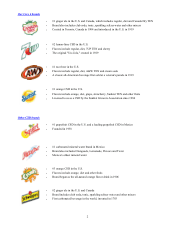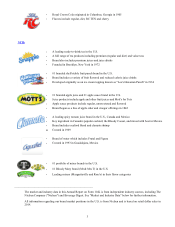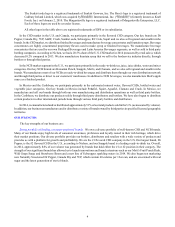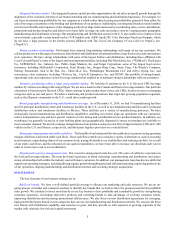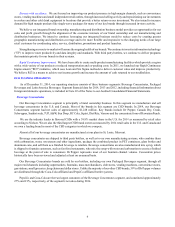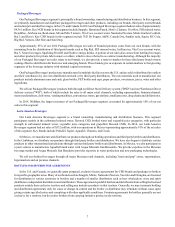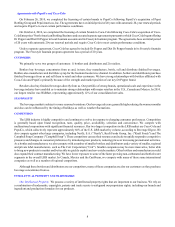Snapple 2014 Annual Report Download - page 15
Download and view the complete annual report
Please find page 15 of the 2014 Snapple annual report below. You can navigate through the pages in the report by either clicking on the pages listed below, or by using the keyword search tool below to find specific information within the annual report.
12
We use both Nielsen and Beverage Digest to assess both our own and our competitors' performance and market share in the
U.S. Different market share rankings can result for a specific beverage category depending on whether data from Nielsen or
Beverage Digest is used, in part because of the differences in the sales channels reported by each source. For example, because
the fountain channel (where we have a relatively small business except for Dr Pepper) is not included in Nielsen data, our market
share using Nielsen data is generally higher for our CSD portfolio than the Beverage Digest data, which does include the fountain
channel.
In this Annual Report on Form 10-K, all information regarding the beverage market in the U.S. is from Beverage Digest, and,
except as otherwise indicated, is from 2013. All information regarding our brand market positions in the U.S. is from Nielsen and
is based on retail dollar sales in 2014.
ITEM 1A. RISK FACTORS
RISKS RELATED TO OUR BUSINESS
In addition to the other information set forth in this report, you should carefully consider the risks described below, which
could materially affect our business, financial condition or future results. Any of the following risks, as well as other risks and
uncertainties, could harm our business and financial condition.
We may not effectively respond to changing consumer preferences, trends, health concerns and other factors.
Consumers' preferences can change due to a variety of factors, including the age and ethnic demographics of the population,
social trends, negative publicity, economic downturn or other factors. For example, consumers are increasingly concerned about
health and wellness, focusing on the caloric intake associated with regular CSDs and the use of artificial sweeteners in diet CSDs.
As such, the demand for CSDs has decreased as consumers have shifted towards NCBs, such as water, ready-to-drink teas and
sports drinks. If we do not effectively anticipate these trends and changing consumer preferences, then quickly develop new
products in response, our sales could suffer. Developing and launching new products can be risky and expensive. We may not be
successful in responding to changing markets and consumer preferences, and some of our competitors may be better able to respond
to these changes, either of which could negatively affect our business and financial performance.
New or proposed beverage taxes or regulations could impact our sales.
During the fourth quarter of 2013, the government of Mexico enacted broad based tax reform, including a one peso per liter
tax on the manufacturing of certain sugar-sweetened beverages, which went into effect January 1, 2014, as a result of concerns
about the public health consequences and health care costs associated with obesity. During the fourth quarter of 2014, the city of
Berkeley, California enacted a one cent per ounce tax on the distribution of certain sugar-sweetened beverages, which went into
effect January 1, 2015. Federal, state, and other local and foreign governments could also impose taxes on sugar-sweetened
beverages as a result of these concerns. Additionally, local and regional governments and school boards have enacted, or have
proposed to enact, regulations restricting the sale of certain types or sizes of soft drinks in municipalities and schools as a result
of these concerns. Any changes of regulations or imposed taxes may reduce consumer demand for our products or could cause us
to raise our prices, both of which could have a material adverse effect on our profitability and negatively affect our business and
financial performance.
We operate in highly competitive markets.
The LRB industry is highly competitive and continues to evolve in response to changing consumer preferences. Competition
is generally based upon brand recognition, taste, quality, price, availability, selection and convenience. Brand recognition can also
be impacted by the effectiveness of our advertising campaigns and marketing programs, as well as our use of social media. We
compete with multinational corporations with significant financial resources. Our two largest competitors in the LRB market are
Coca-Cola and PepsiCo, which represent approximately 60% of the U.S. LRB market by volume, according to Beverage Digest.
We also compete against other large companies, including Nestle, Kraft Foods and Campbell Soup. These competitors can use
their resources and scale to rapidly respond to competitive pressures and changes in consumer preferences by introducing new
products, changing their route to market, reducing prices or increasing promotional activities. As a bottler and manufacturer, we
also compete with a number of smaller bottlers and distributors and a variety of smaller, regional and private label manufacturers,
such as Cott. Smaller companies may be more innovative, better able to bring new products to market and better able to quickly
exploit and serve niche markets. We also compete for contract manufacturing with other bottlers and manufacturers. We have
lower exposure to energy drinks, some of the faster growing NCBs and the bottled water segments in the overall LRB market. In
Canada, Mexico and the Caribbean, we compete with many of these same international companies as well as a number of regional
competitors.


